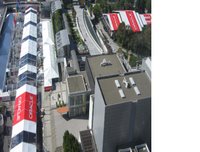For me OOW started on Sunday morning with the ODTUG Oracle Developer Suite Special Interest Group Meeting in the Hilton. In this session 2 Oracle Emps of the Forms and Designer Development Depts answered questions of the audience.
The highlights :
At 6:00 pm Charles Phillips had the honour of kicking of OOW with the Opening Keynote. Charles announced that the Oakland Arena will be renamed to Oracle Arena (according to the basket and ball, it had something to do with basketball....). After that Charles emphasized that all Applications (EBS, JD Edwards, Peoplesoft etc), will be supported and extended "unlimited", next to Fusion. Then he announced - and even live demo'ed! - Oracle Accelerate, a tool to simplify the setup for your Oracle Apps instance, just by answering a few questions.
 At 7:00 the first party of OOW started: The Welcome Reception in the tents on Howard Street.
At 7:00 the first party of OOW started: The Welcome Reception in the tents on Howard Street.
The highlights :
- The main goals for Forms 11 are : better Application Server integration; higher interoperability (with webservices, BPEL and browser); ease of upgrade.
- JInitiator will be replaced by (native) JVM
- WebUtil will be a part of Forms (not a seperate utility anymore)
- Forms PL/SQL scanner that checks the quality of the code
- No plans for extra UI widgets
- Oracle Applications is migrating to Forms 10gR2, so Forms is here to stay
- XML Publisher is the standard reporting tool in Applications (you can imagine the consequences for the future of Oracle Reports)
- Designer 11 will not contain any new functionality, just a new version to keep up with Forms
At 6:00 pm Charles Phillips had the honour of kicking of OOW with the Opening Keynote. Charles announced that the Oakland Arena will be renamed to Oracle Arena (according to the basket and ball, it had something to do with basketball....). After that Charles emphasized that all Applications (EBS, JD Edwards, Peoplesoft etc), will be supported and extended "unlimited", next to Fusion. Then he announced - and even live demo'ed! - Oracle Accelerate, a tool to simplify the setup for your Oracle Apps instance, just by answering a few questions.
 At 7:00 the first party of OOW started: The Welcome Reception in the tents on Howard Street.
At 7:00 the first party of OOW started: The Welcome Reception in the tents on Howard Street.
Comments